NIO
Java NIO(new IO)是java1.4版本开始引入的一个新的API,可以代替标准的IO API,NIO与原来的IO有同样的作用和目的,但是使用方式完全不同,NIO是面向缓冲区的,基于通道的IO操作,NIO以更加高效的方式进行文件操作

NIO系统的核心在于:通道和缓冲区,通道表示打开到IO设备(文件、套接字)的连接,若需要使用NIO系统,需要获取用于连接IO设备的通道以及容纳数据的缓冲区,然后操作缓冲区,对数据进行处理
Channel负责传输,Buffer负责存储
缓冲区:一个用于特定基本数据类型的容器,所有缓冲区都是Buffer抽象类的子类,Buffer主要用于与NIO通道进行交互,数据是从通道读入缓冲区,从缓冲区写入通道中的
Buffer就像是一个数组可以保持多个相容数据类型的数据,根据类型不同(boolean除外),使用相似的方式进行管理数据,只是各自的数据类型不同而已
缓冲区的基本属性:

@Test
public void test1(){
String str = "abcde";
//1. 分配一个指定大小的缓冲区
ByteBuffer buf = ByteBuffer.allocate(1024);
System.out.println("-----------------allocate()----------------");
System.out.println(buf.position());
System.out.println(buf.limit());
System.out.println(buf.capacity());
//2. 利用 put() 存入数据到缓冲区中
buf.put(str.getBytes());
System.out.println("-----------------put()----------------");
System.out.println(buf.position());
System.out.println(buf.limit());
System.out.println(buf.capacity());
//3. 切换读取数据模式
buf.flip();
System.out.println("-----------------flip()----------------");
System.out.println(buf.position());
System.out.println(buf.limit());
System.out.println(buf.capacity());
//4. 利用 get() 读取缓冲区中的数据
byte[] dst = new byte[buf.limit()];
buf.get(dst);
System.out.println(new String(dst, 0, dst.length));
System.out.println("-----------------get()----------------");
System.out.println(buf.position());
System.out.println(buf.limit());
System.out.println(buf.capacity());
//5. rewind() : 可重复读
buf.rewind();
System.out.println("-----------------rewind()----------------");
System.out.println(buf.position());
System.out.println(buf.limit());
System.out.println(buf.capacity());
//6. clear() : 清空缓冲区. 但是缓冲区中的数据依然存在,但是处于“被遗忘”状态
buf.clear();
System.out.println("-----------------clear()----------------");
System.out.println(buf.position());
System.out.println(buf.limit());
System.out.println(buf.capacity());
System.out.println((char)buf.get());
}
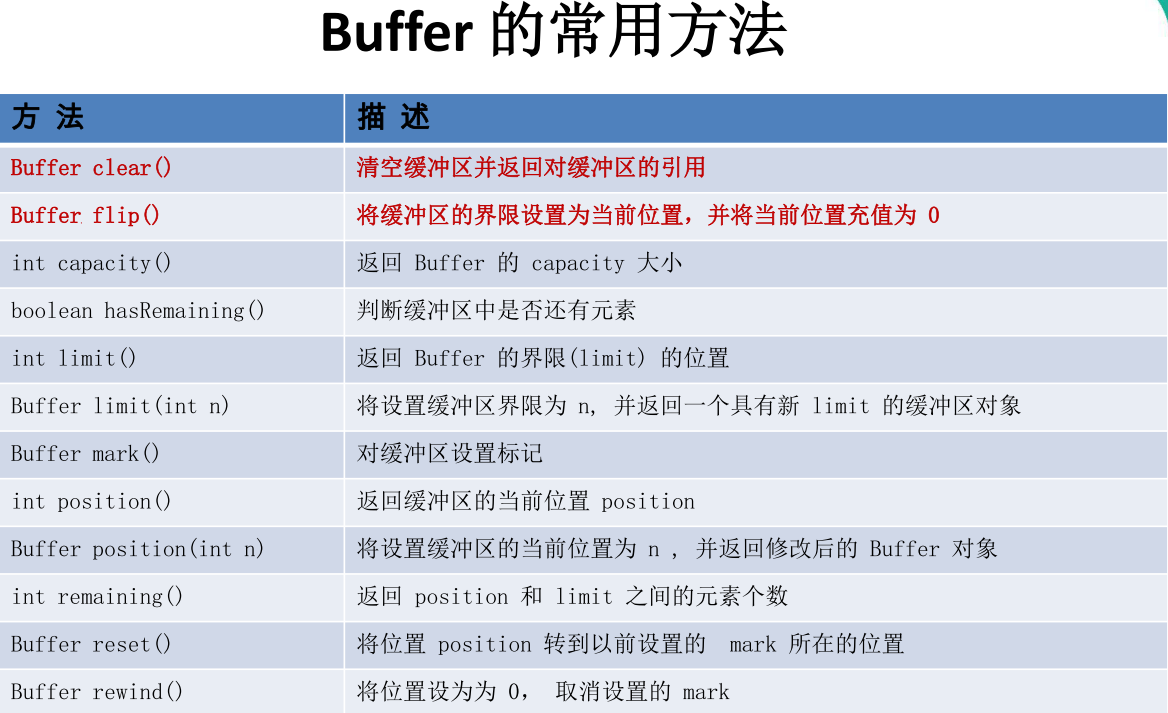
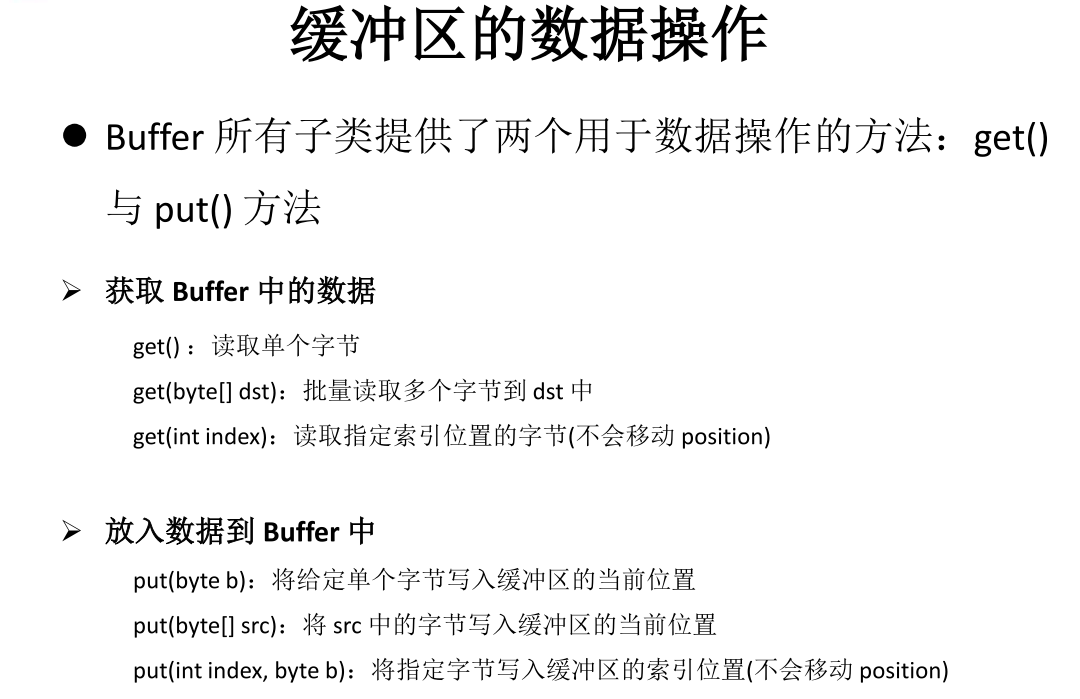
直接缓冲区和非直接缓冲区:字节缓冲区要么是直接缓冲区,要么是非直接缓冲区,如果为直接缓冲区,则java虚拟机会进最大努力直接在此缓冲区上执行本机IO操作,也就是每次调用基础操作系统的一个本机IO操作,虚拟机都会尽量避免将缓冲区的内容复制到中间缓冲区中(或从中间缓冲区中复制内容)
直接字节缓冲区可以通过调用此类的allocateDirect()方法创建,将直接缓冲区主要分配给那些易受基础系统的本机IO操作影响的大型、持久的缓冲,一般情况,最好在直接缓冲区能在程序性能方面带来明显好处时分配给他们
@Test
public void test2(){
String str = "abcde";
ByteBuffer buf = ByteBuffer.allocate(1024);
buf.put(str.getBytes());
buf.flip();
byte[] dst = new byte[buf.limit()];
buf.get(dst, 0, 2);
System.out.println(new String(dst, 0, 2));
System.out.println(buf.position());
//mark() : 标记
buf.mark();
buf.get(dst, 2, 2);
System.out.println(new String(dst, 2, 2));
System.out.println(buf.position());
//reset() : 恢复到 mark 的位置
buf.reset();
System.out.println(buf.position());
//判断缓冲区中是否还有剩余数据
if(buf.hasRemaining()){
//获取缓冲区中可以操作的数量
System.out.println(buf.remaining());
}
}
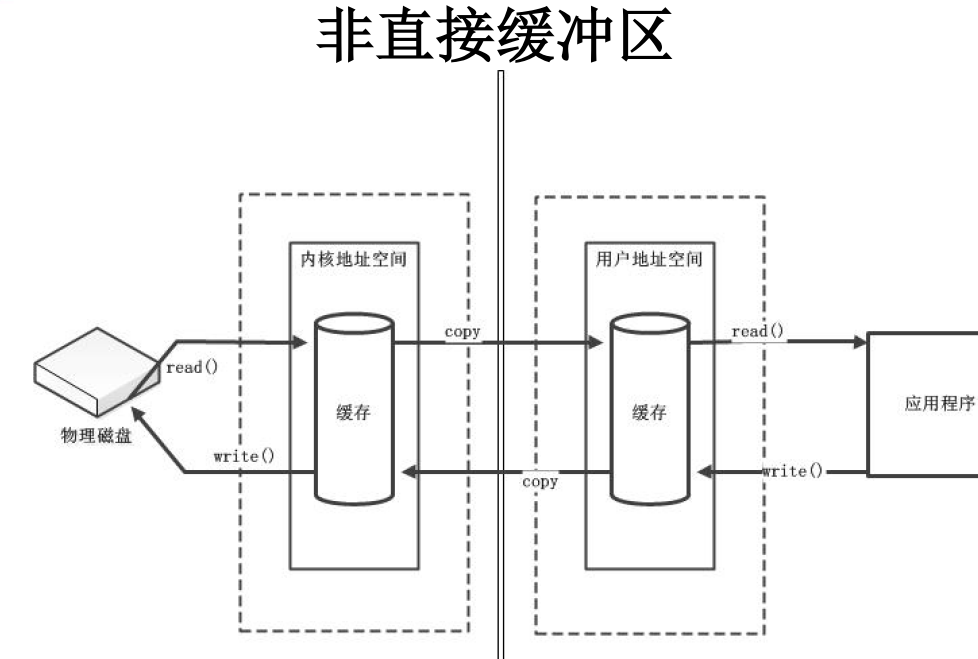
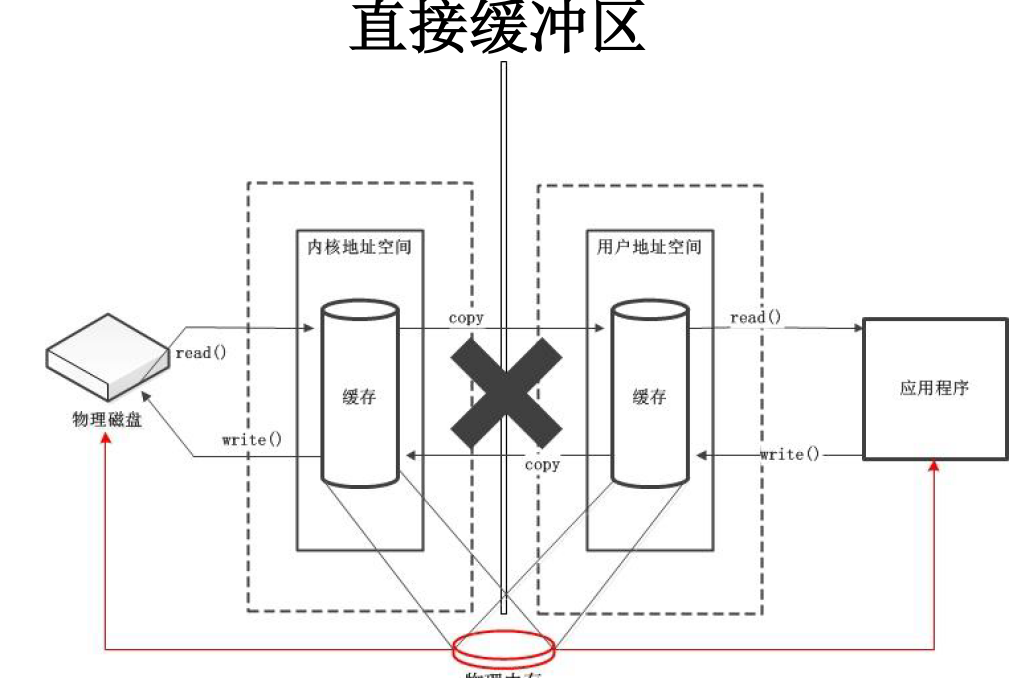
通道表示与IO源与目标打开的连接,通道本身并不能访问数据,通道只能与缓冲区进行交互
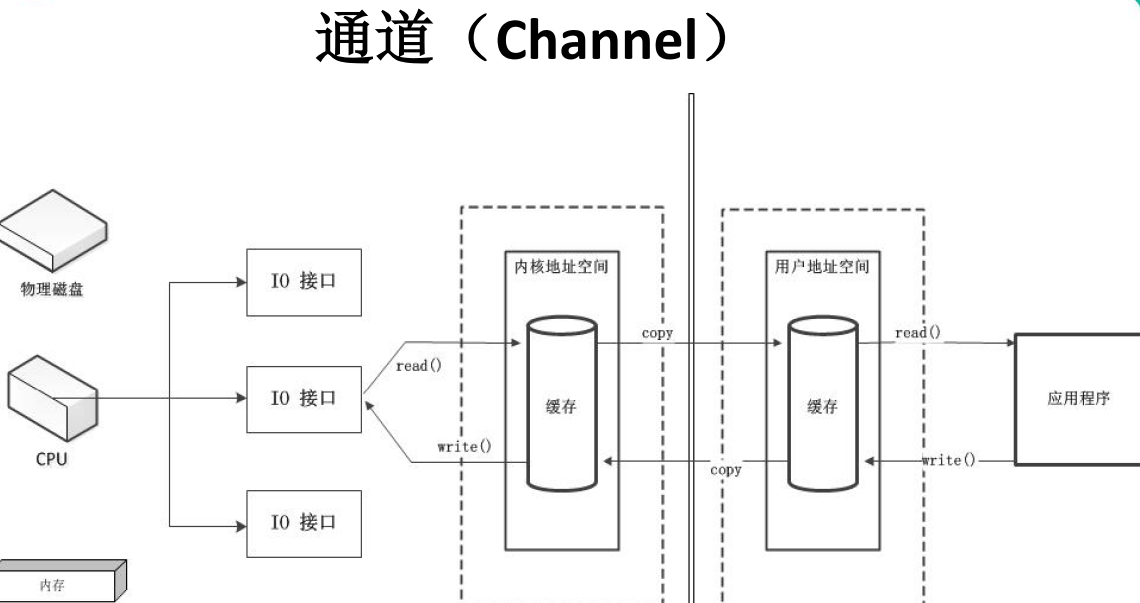
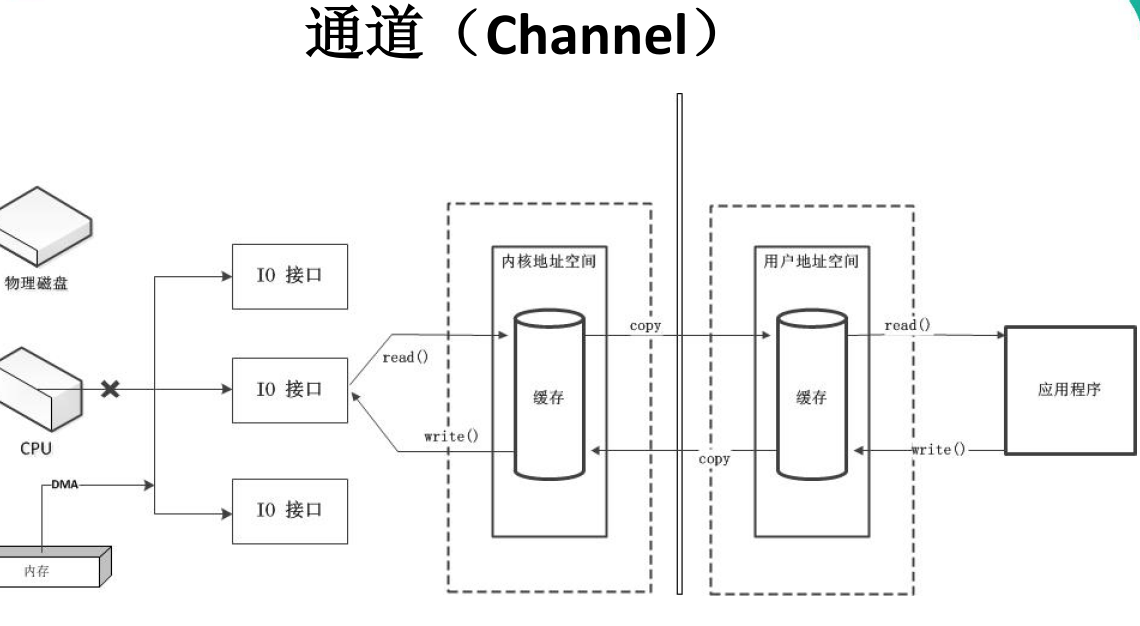

//利用通道完成文件的复制(非直接缓冲区)
@Test
public void test1(){//10874-10953
long start = System.currentTimeMillis();
FileInputStream fis = null;
FileOutputStream fos = null;
//①获取通道
FileChannel inChannel = null;
FileChannel outChannel = null;
try {
fis = new FileInputStream("d:/1.mkv");
fos = new FileOutputStream("d:/2.mkv");
inChannel = fis.getChannel();
outChannel = fos.getChannel();
//②分配指定大小的缓冲区
ByteBuffer buf = ByteBuffer.allocate(1024);
//③将通道中的数据存入缓冲区中
while(inChannel.read(buf) != -1){
buf.flip(); //切换读取数据的模式
//④将缓冲区中的数据写入通道中
outChannel.write(buf);
buf.clear(); //清空缓冲区
}
} catch (IOException e) {
e.printStackTrace();
} finally {
if(outChannel != null){
try {
outChannel.close();
} catch (IOException e) {
e.printStackTrace();
}
}
if(inChannel != null){
try {
inChannel.close();
} catch (IOException e) {
e.printStackTrace();
}
}
if(fos != null){
try {
fos.close();
} catch (IOException e) {
e.printStackTrace();
}
}
if(fis != null){
try {
fis.close();
} catch (IOException e) {
e.printStackTrace();
}
}
}
long end = System.currentTimeMillis();
System.out.println("耗费时间为:" + (end - start));
}
//使用直接缓冲区完成文件的复制(内存映射文件)
@Test
public void test2() throws IOException{//2127-1902-1777
long start = System.currentTimeMillis();
FileChannel inChannel = FileChannel.open(Paths.get("d:/1.mkv"), StandardOpenOption.READ);
FileChannel outChannel = FileChannel.open(Paths.get("d:/2.mkv"), StandardOpenOption.WRITE, StandardOpenOption.READ, StandardOpenOption.CREATE);
//内存映射文件
MappedByteBuffer inMappedBuf = inChannel.map(MapMode.READ_ONLY, 0, inChannel.size());
MappedByteBuffer outMappedBuf = outChannel.map(MapMode.READ_WRITE, 0, inChannel.size());
//直接对缓冲区进行数据的读写操作
byte[] dst = new byte[inMappedBuf.limit()];
inMappedBuf.get(dst);
outMappedBuf.put(dst);
inChannel.close();
outChannel.close();
long end = System.currentTimeMillis();
System.out.println("耗费时间为:" + (end - start));
}
//通道之间的数据传输(直接缓冲区)
@Test
public void test3() throws IOException{
FileChannel inChannel = FileChannel.open(Paths.get("d:/1.mkv"), StandardOpenOption.READ);
FileChannel outChannel = FileChannel.open(Paths.get("d:/2.mkv"), StandardOpenOption.WRITE, StandardOpenOption.READ, StandardOpenOption.CREATE);
// inChannel.transferTo(0, inChannel.size(), outChannel);
outChannel.transferFrom(inChannel, 0, inChannel.size());
inChannel.close();
outChannel.close();
}
//分散和聚集
@Test
public void test4() throws IOException{
RandomAccessFile raf1 = new RandomAccessFile("1.txt", "rw");
//1. 获取通道
FileChannel channel1 = raf1.getChannel();
//2. 分配指定大小的缓冲区
ByteBuffer buf1 = ByteBuffer.allocate(100);
ByteBuffer buf2 = ByteBuffer.allocate(1024);
//3. 分散读取
ByteBuffer[] bufs = {buf1, buf2};
channel1.read(bufs);
for (ByteBuffer byteBuffer : bufs) {
byteBuffer.flip();
}
System.out.println(new String(bufs[0].array(), 0, bufs[0].limit()));
System.out.println("-----------------");
System.out.println(new String(bufs[1].array(), 0, bufs[1].limit()));
//4. 聚集写入
RandomAccessFile raf2 = new RandomAccessFile("2.txt", "rw");
FileChannel channel2 = raf2.getChannel();
channel2.write(bufs);
}
@Test
public void test5(){
Map<String, Charset> map = Charset.availableCharsets();
Set<Entry<String, Charset>> set = map.entrySet();
for (Entry<String, Charset> entry : set) {
System.out.println(entry.getKey() + "=" + entry.getValue());
}
}
//字符集
@Test
public void test6() throws IOException{
Charset cs1 = Charset.forName("GBK");
//获取编码器
CharsetEncoder ce = cs1.newEncoder();
//获取解码器
CharsetDecoder cd = cs1.newDecoder();
CharBuffer cBuf = CharBuffer.allocate(1024);
cBuf.put("好好学习、天天向上");
cBuf.flip();
//编码
ByteBuffer bBuf = ce.encode(cBuf);
for (int i = 0; i < 12; i++) {
System.out.println(bBuf.get());
}
//解码
bBuf.flip();
CharBuffer cBuf2 = cd.decode(bBuf);
System.out.println(cBuf2.toString());
System.out.println("------------------------------------------------------");
Charset cs2 = Charset.forName("GBK");
bBuf.flip();
CharBuffer cBuf3 = cs2.decode(bBuf);
System.out.println(cBuf3.toString());
}
/*
* 一、通道(Channel):用于源节点与目标节点的连接。在 Java NIO 中负责缓冲区中数据的传输。Channel 本身不存储数据,因此需要配合缓冲区进行传输。
*
* 二、通道的主要实现类
* java.nio.channels.Channel 接口:
* |--FileChannel
* |--SocketChannel
* |--ServerSocketChannel
* |--DatagramChannel
*
* 三、获取通道
* 1. Java 针对支持通道的类提供了 getChannel() 方法
* 本地 IO:
* FileInputStream/FileOutputStream
* RandomAccessFile
*
* 网络IO:
* Socket
* ServerSocket
* DatagramSocket
*
* 2. 在 JDK 1.7 中的 NIO.2 针对各个通道提供了静态方法 open()
* 3. 在 JDK 1.7 中的 NIO.2 的 Files 工具类的 newByteChannel()
*
* 四、通道之间的数据传输
* transferFrom()
* transferTo()
*
* 五、分散(Scatter)与聚集(Gather)
* 分散读取(Scattering Reads):将通道中的数据分散到多个缓冲区中
* 聚集写入(Gathering Writes):将多个缓冲区中的数据聚集到通道中
*
* 六、字符集:Charset
* 编码:字符串 -> 字节数组
* 解码:字节数组 -> 字符串
*
*/
/*
* 一、使用 NIO 完成网络通信的三个核心:
*
* 1. 通道(Channel):负责连接
*
* java.nio.channels.Channel 接口:
* |--SelectableChannel
* |--SocketChannel
* |--ServerSocketChannel
* |--DatagramChannel
*
* |--Pipe.SinkChannel
* |--Pipe.SourceChannel
*
* 2. 缓冲区(Buffer):负责数据的存取
*
* 3. 选择器(Selector):是 SelectableChannel 的多路复用器。用于监控 SelectableChannel 的 IO 状况
*
*/
public class TestBlockingNIO {
//客户端
@Test
public void client() throws IOException{
//1. 获取通道
SocketChannel sChannel = SocketChannel.open(new InetSocketAddress("127.0.0.1", 9898));
FileChannel inChannel = FileChannel.open(Paths.get("1.jpg"), StandardOpenOption.READ);
//2. 分配指定大小的缓冲区
ByteBuffer buf = ByteBuffer.allocate(1024);
//3. 读取本地文件,并发送到服务端
while(inChannel.read(buf) != -1){
buf.flip();
sChannel.write(buf);
buf.clear();
}
//4. 关闭通道
inChannel.close();
sChannel.close();
}
//服务端
@Test
public void server() throws IOException{
//1. 获取通道
ServerSocketChannel ssChannel = ServerSocketChannel.open();
FileChannel outChannel = FileChannel.open(Paths.get("2.jpg"), StandardOpenOption.WRITE, StandardOpenOption.CREATE);
//2. 绑定连接
ssChannel.bind(new InetSocketAddress(9898));
//3. 获取客户端连接的通道
SocketChannel sChannel = ssChannel.accept();
//4. 分配指定大小的缓冲区
ByteBuffer buf = ByteBuffer.allocate(1024);
//5. 接收客户端的数据,并保存到本地
while(sChannel.read(buf) != -1){
buf.flip();
outChannel.write(buf);
buf.clear();
}
//6. 关闭通道
sChannel.close();
outChannel.close();
ssChannel.close();
}
}
public class TestBlockingNIO2 {
//客户端
@Test
public void client() throws IOException{
SocketChannel sChannel = SocketChannel.open(new InetSocketAddress("127.0.0.1", 9898));
FileChannel inChannel = FileChannel.open(Paths.get("1.jpg"), StandardOpenOption.READ);
ByteBuffer buf = ByteBuffer.allocate(1024);
while(inChannel.read(buf) != -1){
buf.flip();
sChannel.write(buf);
buf.clear();
}
sChannel.shutdownOutput();
//接收服务端的反馈
int len = 0;
while((len = sChannel.read(buf)) != -1){
buf.flip();
System.out.println(new String(buf.array(), 0, len));
buf.clear();
}
inChannel.close();
sChannel.close();
}
//服务端
@Test
public void server() throws IOException{
ServerSocketChannel ssChannel = ServerSocketChannel.open();
FileChannel outChannel = FileChannel.open(Paths.get("2.jpg"), StandardOpenOption.WRITE, StandardOpenOption.CREATE);
ssChannel.bind(new InetSocketAddress(9898));
SocketChannel sChannel = ssChannel.accept();
ByteBuffer buf = ByteBuffer.allocate(1024);
while(sChannel.read(buf) != -1){
buf.flip();
outChannel.write(buf);
buf.clear();
}
//发送反馈给客户端
buf.put("服务端接收数据成功".getBytes());
buf.flip();
sChannel.write(buf);
sChannel.close();
outChannel.close();
ssChannel.close();
}
}
/*
* 一、使用 NIO 完成网络通信的三个核心:
*
* 1. 通道(Channel):负责连接
*
* java.nio.channels.Channel 接口:
* |--SelectableChannel
* |--SocketChannel
* |--ServerSocketChannel
* |--DatagramChannel
*
* |--Pipe.SinkChannel
* |--Pipe.SourceChannel
*
* 2. 缓冲区(Buffer):负责数据的存取
*
* 3. 选择器(Selector):是 SelectableChannel 的多路复用器。用于监控 SelectableChannel 的 IO 状况
*
*/
public class TestNonBlockingNIO {
//客户端
@Test
public void client() throws IOException{
//1. 获取通道
SocketChannel sChannel = SocketChannel.open(new InetSocketAddress("127.0.0.1", 9898));
//2. 切换非阻塞模式
sChannel.configureBlocking(false);
//3. 分配指定大小的缓冲区
ByteBuffer buf = ByteBuffer.allocate(1024);
//4. 发送数据给服务端
Scanner scan = new Scanner(System.in);
while(scan.hasNext()){
String str = scan.next();
buf.put((new Date().toString() + "\n" + str).getBytes());
buf.flip();
sChannel.write(buf);
buf.clear();
}
//5. 关闭通道
sChannel.close();
}
//服务端
@Test
public void server() throws IOException{
//1. 获取通道
ServerSocketChannel ssChannel = ServerSocketChannel.open();
//2. 切换非阻塞模式
ssChannel.configureBlocking(false);
//3. 绑定连接
ssChannel.bind(new InetSocketAddress(9898));
//4. 获取选择器
Selector selector = Selector.open();
//5. 将通道注册到选择器上, 并且指定“监听接收事件”
ssChannel.register(selector, SelectionKey.OP_ACCEPT);
//6. 轮询式的获取选择器上已经“准备就绪”的事件
while(selector.select() > 0){
//7. 获取当前选择器中所有注册的“选择键(已就绪的监听事件)”
Iterator<SelectionKey> it = selector.selectedKeys().iterator();
while(it.hasNext()){
//8. 获取准备“就绪”的是事件
SelectionKey sk = it.next();
//9. 判断具体是什么事件准备就绪
if(sk.isAcceptable()){
//10. 若“接收就绪”,获取客户端连接
SocketChannel sChannel = ssChannel.accept();
//11. 切换非阻塞模式
sChannel.configureBlocking(false);
//12. 将该通道注册到选择器上
sChannel.register(selector, SelectionKey.OP_READ);
}else if(sk.isReadable()){
//13. 获取当前选择器上“读就绪”状态的通道
SocketChannel sChannel = (SocketChannel) sk.channel();
//14. 读取数据
ByteBuffer buf = ByteBuffer.allocate(1024);
int len = 0;
while((len = sChannel.read(buf)) > 0 ){
buf.flip();
System.out.println(new String(buf.array(), 0, len));
buf.clear();
}
}
//15. 取消选择键 SelectionKey
it.remove();
}
}
}
}
public class TestNonBlockingNIO2 {
@Test
public void send() throws IOException{
DatagramChannel dc = DatagramChannel.open();
dc.configureBlocking(false);
ByteBuffer buf = ByteBuffer.allocate(1024);
Scanner scan = new Scanner(System.in);
while(scan.hasNext()){
String str = scan.next();
buf.put((new Date().toString() + ":\n" + str).getBytes());
buf.flip();
dc.send(buf, new InetSocketAddress("127.0.0.1", 9898));
buf.clear();
}
dc.close();
}
@Test
public void receive() throws IOException{
DatagramChannel dc = DatagramChannel.open();
dc.configureBlocking(false);
dc.bind(new InetSocketAddress(9898));
Selector selector = Selector.open();
dc.register(selector, SelectionKey.OP_READ);
while(selector.select() > 0){
Iterator<SelectionKey> it = selector.selectedKeys().iterator();
while(it.hasNext()){
SelectionKey sk = it.next();
if(sk.isReadable()){
ByteBuffer buf = ByteBuffer.allocate(1024);
dc.receive(buf);
buf.flip();
System.out.println(new String(buf.array(), 0, buf.limit()));
buf.clear();
}
}
it.remove();
}
}
}
@Test
public void test1() throws IOException{
//1. 获取管道
Pipe pipe = Pipe.open();
//2. 将缓冲区中的数据写入管道
ByteBuffer buf = ByteBuffer.allocate(1024);
Pipe.SinkChannel sinkChannel = pipe.sink();
buf.put("通过单向管道发送数据".getBytes());
buf.flip();
sinkChannel.write(buf);
//3. 读取缓冲区中的数据
Pipe.SourceChannel sourceChannel = pipe.source();
buf.flip();
int len = sourceChannel.read(buf);
System.out.println(new String(buf.array(), 0, len));
sourceChannel.close();
sinkChannel.close();
}






